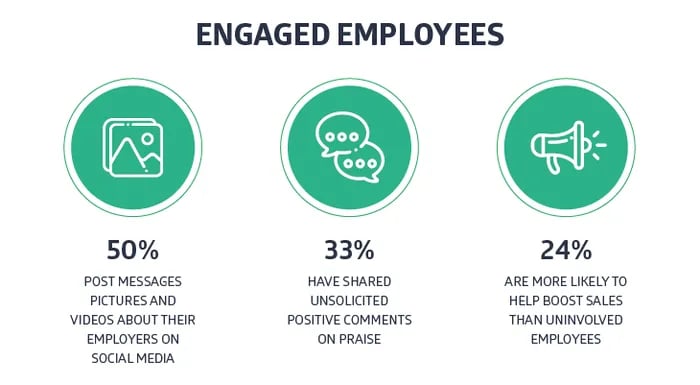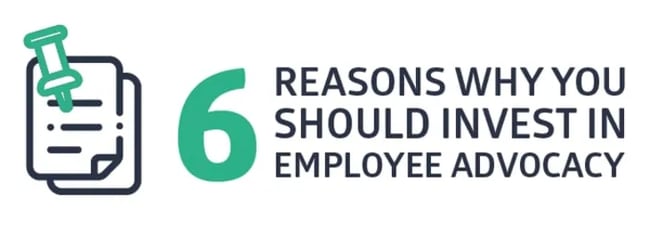How to Boost Engagement and Sales with Employee Brand Advoacy

In today’s interconnected world consumers are constantly bombarded with brand messaging, and if anyone can get through all that clutter it’s your employees. They are a most powerful asset for your company: people will trust them way more than they trust your corporate facade, which is why they have the potential to amplify your brand, boost your sales, and drive engagement. All it takes is for you to make them your advocates!
Here’s the thing, people believe people — they don’t want to hear from your corporate accounts. They want to hear from your people — customers, partners, and others.
Your employees are a powerful asset: if your company strategy is centered around them, you can turn them from potential to active assets and start seeing results pretty soon. The opposite would be a huge detriment to your business. With your employees' help, you can easily spread your brand’s story and vision on social media sites.
Build your brand with advocacy and make sure that your employees are your biggest cheerleaders.
5 dangers of not having an employee brand advocacy program
If the benefits of encouraging and managing an internal advocacy program aren’t enough for you to realize how pressing this is, maybe the dangers of failing to do so will. Here’s what you’re risking if you delegate employee advocacy to the sidelines:
- You risk getting left behind. Essentially, the digital transformation wagon will be passing you by. Most of your competitors will jump at any opportunity to streamline their business by using profit-boosting online platforms and tactics.
- You will pay more for social media and content. Creating content is a real budget drain. So is paid promotion on social media sites. Employee advocates can be mobilized to create and share content for a fraction of the cost it would cost you to outsource those activities. Plus, you know, employees get a lot more traction with potential customers.
- Your cost per lead will remain the same. While everyone else will be decreasing theirs. More awareness, bigger networks, and glowing online reviews can trigger potential prospects to pull the purchasing trigger before you have to invest too much.
- You will struggle to earn trust. As mentioned, people trust people, not brands. The fewer voices you have out there vouching for you, the harder it will be for people to trust you. You will be viewed as yet another corporate shill and that’s always bad for business.
- You will be letting a valuable customer acquisition channel slip through your fingers. More and more consumers are basing their purchasing decisions on online reviews, social media discussion, and what’s trickling down the online grapevine. If you’re not there to participate, you’re missing out.
Stay ahead of your competition and promote your authentic brand with your employees
Try brand advocacy nowActivate employee brand advocacy
Why not go after the low-hanging fruit as well?
Your employees have a big incentive to be your advocates — your company is their place of work, and what benefits you, benefits them as well. Most of the time, employee advocacy is already happening in companies, regardless of whether it’s being managed or not:
- 47% of employees are already communicating with customers in an online environment by answering questions, sticking up for the company, or through other activities.
- 50% of them are already talking about the company they work for, even when not encouraged by the company itself.

Innovative advocacy platforms allow you to harness the potential of both groups and use their powerful synergy to reach even more potential customers with unique and trustworthy messages that will convince them to choose you.
6 reasons to invest in employee brand advocacy

Your employees are an existing resource that can be further utilized to bring benefit your company. The cost of starting and managing an employee advocacy program is significantly lower than the cost of launching an advocacy program with customers.
However, it still delivers impressive results:
- Online reputation management. 6 out of 10 employees will go out of their way to defend their employer to friends, family, and online connections. With careful management, you could easily bump that number even higher.
- Online content creation and distribution. Your employees can create meaningful content and distribute it over social media for basically no money at all, and with greater results.
- Sales boost. With just a 12% increase in employee advocacy, you could easily double your sales without utilizing other channels that will drain your resources without delivering great results.
- Expanded reach. Your reach grows with every employee advocate to include their social connections. This quickly surpasses what a company could hope to reach organically. In fact, around 90% of people you reach through your employees will be hearing about your brand for the first time.
- Authenticity boost. There’s nothing authentic in a corporate social media account, which is why people don’t trust them anymore. Build authenticity one advocate at a time, and gain people’s trust thanks to the real people behind your brand. When that happens, every message you put out there will be amplified by real, human voices.
- Minimal investment. Employee advocates are not looking for an extensive rewards program. Being already invested in the success of your company, they are looking for recognition, not rewards, and a simple thank you will go a long way.
Give employee brand advocacy a chance now
Get in touchLaying the foundations for employee brand advocacy
The thing is, getting employees to participate in an advocacy program shouldn’t be too difficult. Their main incentive is that if the company does well, they do too — and we're talking potential pay increase, job security and stability, and advancement opportunities.
Top management, on the other hand, might prove to be a tougher nut to crack. It will all come to the bottom line here, so you have to have the numbers to prove future growth as a direct consequence of employee advocacy.
That shouldn’t be too difficult to calculate but you’ve got to come prepared. Ideally, leadership will be involved in this project from the start — this will make your life easier when it comes to budgets and getting employees on board.
You want as many employees participating in your advocacy program as possible. Of course, you will never be able to motivate everyone, but as the involvement grows, so will your reach and your revenue.
Most companies choose to start small, ironing out the kinks before rolling out the employee advocacy program company-wide.
Once you get the leadership to sign off on everything, it’s time to start preparing. Get people who use social media in their day-to-day job to join the program first — marketing, communications, sales, social media managers, and talent acquisition (HR), and form a team that will create an advocacy plan.
When you’re ready to roll out, assign someone (one person or a group of people) who will be responsible for managing the program. They will coordinate with others and set up campaign goals, measure success, reward employee advocates for participation, onboard others to the program, and answer employee advocacy-related questions.
Setting up goals and KPIs
When setting up goals and KPIs for your employee advocacy program, ask yourself one question: what do I want to accomplish? It’s important that advocacy goals are aligned with the goals of the specific departments it aims to help.
Get specific and quantify every goal. Once you assign a number to something, that makes it that much easier to achieve.
A good employee advocacy platform allows you to create targeted campaigns that will help you reach your goals — social media sharing, content creation, review actions, online reputation, and so on, the more specific, the better.
In order to achieve most of these goals, you will have to provide your advocates with powerful, informational, and creative content. Some of that content can be done by the company but don’t miss out on the opportunity to capitalize on user-generated content. With just a few simple instructions, you can turn your employees into a veritable content mill.
Remember though — employee advocacy is not only about boosting your social media visibility and (potentially) sales.
Employees participating in these programs often feel a tighter connection with the company, and that can result in increased productivity and morale.
In the end, your bottom line benefits no matter how you choose to look at it.
Managing your advocacy program
Managing small details of an employee advocacy program is done with the help of an advocacy platform. Your best bet is platforms that can be used for both employee and customer advocacy because they are easier to manage and reduce your overhead cost.
Keeping the momentum going can prove a bit harder for some. In the beginning, your advocacy efforts will be seen as something new and shiny, so employees will want to participate. After a while, there’s a possibility that the novelty will wear off.
Here’s how you combat that and keep your employees engaged:
- Customize challenges and campaigns. Know your employees and segment campaigns according to departments. If you present people with something they are interested in or something that boosts their department’s goals, they are more likely to participate.
- Make it easy to participate. Don’t make people jump through hoops to contribute. Choose an easy-to-use advocacy platform and keep your goals simple and easily obtainable.
- Hand power to employees. Don’t micromanage every aspect of the program. Setting ground rules and letting advocates call some of the shots will empower them and give them some control. With control, they will take on a mantle of responsibility as well.
- Reward their participation. Employee advocacy asks your employees to go above and beyond. Reward their actions with appropriate rewards. Sometimes, all that’s necessary is a bit of recognition.
Measuring actions and rewarding your employee
The last step of your employee advocacy program is ensuring quality measurements. Keeping track of important metrics will let you know which campaigns are working and which are not, and you can use that to make decisions about where you’re going to focus your efforts the most.
To make things easier, choose an advocacy platform that gives you a clear overview of what’s been done and what are the projected benefits.
In addition to the measurement part being crucial to keeping you on the right track, it’s also important when it comes to rewarding your employee advocates. When you know exactly what they’ve done and when they’ve done it, you can start rewarding them appropriately.
When it comes to rewards, it’s important not to overdo it — you don’t want to ‘pay’ your employees for their advocacy actions. Recognition often works better, and it’s completely free!
However, even though your employees will be getting some benefits just by participating, setting up a small reward pool is still a good idea. Things that don’t cost much but come with bragging rights include branded merchandise, a longer break, extra lunch choices, and so on.
You can throw in some big-ticket items in there, such as letting the best performing department choose a conference they want to attend but remember to use those sporadically and for big achievements.
Want to take a look at Ambassify's gamification & rewards options?
Take a 15-minute platform tourIncrease awareness, leads, and sales
A handful of good employee advocates can do wonders for your company. Once you start growing their numbers and managing their efforts, they can supercharge your marketing efforts and contribute tremendously to your bottom line.
All it takes is a little effort and coordination coupled with a lot of vision and drive to tap into your biggest resource — the human resource.